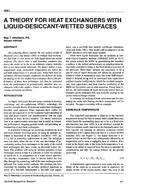Description
The theory extends the wet surface model of Maclaine-Cross and Banks (1981) to include heat exchangers that heat or cool moist air with liquid-desiccant-wetted surfaces. The theory uses a wall boundary condition that forces the moist air to be at an arbitrary relative humidity that is less than totally saturated. The theory defines a new temperature scale (brine-bulb temperature) for which the wet-bulb temperature is a special case. Brine-bulb heat capacitance and heat transfer coefficient are defined. By using an analogy to the dry surface heat exchanger theory, the performance of these heat exchangers can then be estimated from the performance of geometrically identical heat exchangers with a dry surface. Charts to utilise the theory at various elevations are shown.
KEYWORDS: year 1995, heat exchangers, desiccants, liquids, surfaces, wet, heating, cooling, relative humidity, brine, temperature, wet bulb temperature, comparing, heat transfer coefficient, performance, calculating, heat flow, cross flow heat exchangers
Citation: ASHRAE Trans. 1995, Vol.101, Part 1, Paper number 3861, 317-325, 5 figs., 2 tabs. 5 refs.
Product Details
- Published:
- 1995
- File Size:
- 1 file , 770 KB
- Product Code(s):
- D-16735




